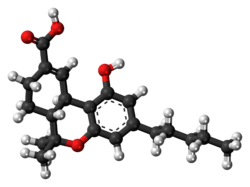11-nor-9-carboxy-THC
 |
|
 |
|
| Clinical data | |
|---|---|
| Pregnancy category |
|
| Routes of administration |
Variable |
| Pharmacokinetic data | |
| Bioavailability | Variable |
| Metabolism | Variable |
| Biological half-life | 5.2 to 6.2 days |
| Excretion | Variable |
| Identifiers | |
|
|
| CAS Number | |
| PubChem CID | |
| ChemSpider | |
| Chemical and physical data | |
| Formula | C21H28O4 |
| Molar mass | 344.45 g·mol−1 |
| 3D model (Jmol) | |
|
|
|
|
|
|
|
11-Nor-9-carboxy-THC, also known as 11-nor-9-carboxy-delta-9-tetrahydrocannabinol, 11-nor-9-carboxy-delta-9-THC, 11-COOH-THC, THC-COOH, and THC-11-oic acid, is the main secondary metabolite of tetrahydrocannabinol (THC) which is formed in the body after cannabis is consumed.
11-COOH-THC is formed in the body by oxidation of the active metabolite 11-Hydroxy-THC (also known as 11-OH-THC) by liver enzymes. It is then metabolized further by conjugation with glucuronide, forming a water-soluble congener which can be more easily excreted by the body.
11-COOH-THC is not psychoactive itself, but has a long half-life in the body of up to several days (or even weeks in very heavy users), making it the main metabolite tested for when blood or urine testing for cannabis use. More selective tests are able to distinguish between 11-OH-THC and 11-COOH-THC, which can help determine how recently cannabis was consumed; if only 11-COOH-THC is present then the cannabis was used some time ago and any impairment in cognitive ability or motor function will have dissipated, whereas if both 11-OH-THC and 11-COOH-THC are present then the cannabis was consumed more recently and motor impairment may still be present.
Some jurisdictions where cannabis use is decriminalized or permitted under some circumstances use such tests when determining whether drivers were legally intoxicated and therefore unfit to drive, with the comparative levels of THC, 11-OH-THC and 11-COOH-THC being used to derive a "blood cannabis level" analogous to the blood alcohol level used in prosecuting impaired drivers. On the other hand, in jurisdictions where cannabis is completely illegal, any detectable levels of 11-COOH-THC may be deemed to constitute driving while intoxicated, even though this approach has been criticized as tantamount to prohibition of "driving whilst being a recent user of cannabis" regardless of the presence or absence of any actual impairment that might impact on driving performance.
While 11-COOH-THC does not have any psychoactive effects in its own right, it may still have a role in the analgesic and antiinflammatory effects of cannabis, and has also been shown to moderate the effects of THC itself which may help explain the difference in subjective effects seen between occasional and regular users of cannabis.
...
Wikipedia
